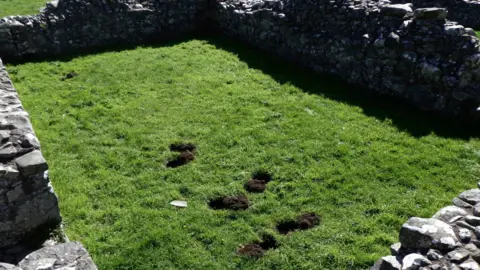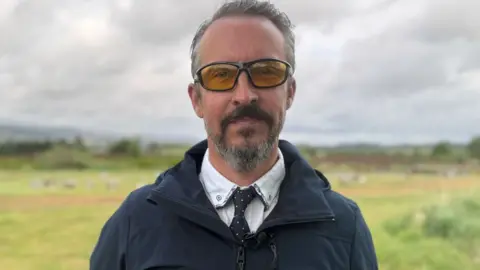'If you damage heritage, you may end up with criminal record'
 BBC
BBCMore than 100 specially protected archaeological sites and historic monuments have been damaged or vandalised in Northern Ireland over the last five years.
Most of the breaches occurred on, or near, farmland including an ancient field system in County Antrim and a centuries-old ceremonial site in County Tyrone.
There are 2,000 historic monuments in Northern Ireland that are protected by law, with some dating back almost 10,000 years.
The latest figures on damage and vandalism have led to fresh calls for more awareness to be raised around the importance of such historical sites and monuments.
 © Crown DfC Historic Environment Division
© Crown DfC Historic Environment DivisionThe Department for Communities has responsibility for protecting historic monuments.
Paul Logue, from the department's historic environment division, said archaeological sites "represent a unique source of information about the lives of our ancestors and how they adapted to and changed their environment".
"Unauthorised works at scheduled sites remove or degrade that archaeological source of information and can be likened to removing an important book from a library and burning it before anyone has had a chance to read it."
What are historic monuments?
There are currently about 35,500 archaeological monuments recorded in the Historic Environment Record of Northern Ireland (HERoNI).
But only about 2,000 of them are scheduled, which means they have statutory protection.
They include many prehistoric sites, forts, churches, castles, maritime sites, and also more recent industrial and defence heritage.
New sites and monuments are discovered every year, often during building excavations, the farming of land and changes in weather conditions revealing ancient sites.
BBC News NI previously reported on how in 2022 a spell of hot weather dried up a swamp in the Loup area that had been concealing a man-made island, known as a crannog.

Special permission must be sought before any works are carried out on scheduled monuments to protect them from damage.
Failure to get the proper permissions or unlawfully disturbing them can lead to a court summons and a fine.
In January 2024, a building contractor was fined £50,000 for demolishing a protected historic monument on a site he intended to develop in County Antrim.
Figures obtained by BBC News NI show that there have been more than 100 breach cases at scheduled monuments in the last five years.
A breakdown of the figures include damage to an ancient field system in County Antrim and a unique set of historic limekilns near Lisburn.
Other incidents include graffiti at a 5,000-year-old tomb site open to the public in County Down.
A path was also unlawfully inserted into an ancient ceremonial site near a burial cairn in the historic Davagh forest in County Tyrone.
Davagh Forest is located at the foot of the Sperrin Mountains where a number of significant archaeological finds have been made.
These include the Beaghmore Stone Circles which were discovered in the late 1930s when a local worker, George Barnett, was cutting peat.
 © Crown DfC Historic Environment Division
© Crown DfC Historic Environment DivisionDamage was also recorded at a number of historic canals in Newry and near the River Lagan in Belfast.
Illegal metal detecting was also a problem and in one instance a number of large holes were dug up at a medieval abbey site in County Down.
'Farmers are responsible people'
Some of the most serious damage cases occurred during the Covid period and about 30% of breaches occurred in urban areas, but most breaches were on farmland.
Paul Logue said: "The high percentage of farmland cases is most likely because Northern Ireland has a large amount of farmland in our landscape and the overwhelming number of protected monuments are on farmland.
"But overwhelmingly, we believe that Northern Ireland landowners and farmers are responsible people who in many cases have carefully looked after monuments on their land for generations. However, like any other section of society, a minority do not act responsibly."
Seán Clarke is a Sinn Fein councillor and farmer from Broughderg who has reported the discovery of several historic artefacts from the land during his working life.

Along with the local history group, he was instrumental in discovering a prehistoric site surrounding the ruins of an old school from the 1800s.
He said: "We noticed that there was this deep bank in a double ring shape that surrounded the old playground, and we began to realise this was something much older.
"We reported it to the authorities and they said they believed it was a prehistoric ceremonial site, so we helped get it reported and registered."
He added: "Down the years, even on my own land, I've discovered different things like old standing stones and stone circles.
"It's so important to protect these artefacts because they're part of our story, part of our past and once they're gone, they're gone forever, they can't be replicated."

Mr Logue added: "The reality is we need the message out there that if you do damage heritage, you may end up with a criminal record.
"And that's not what we want, so we would just ask people to be cautious and remember these places and monuments are telling important stories about humanity."
